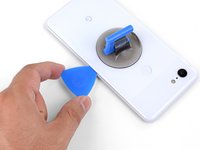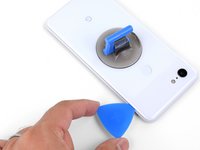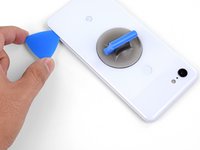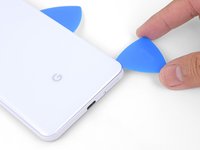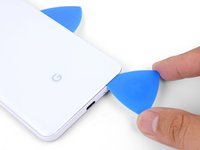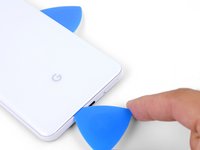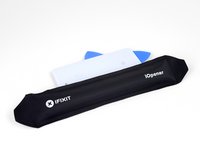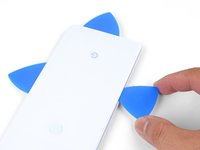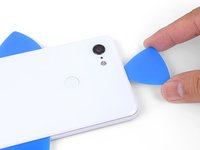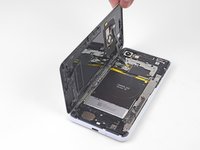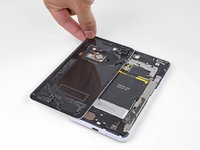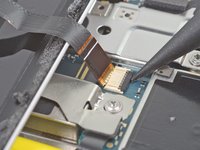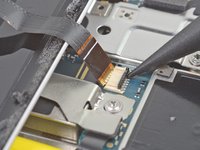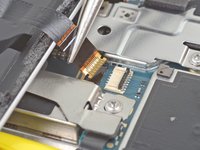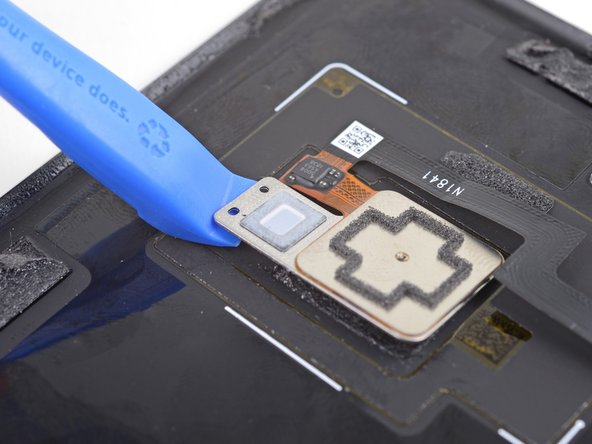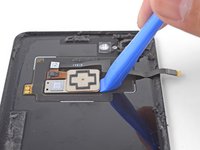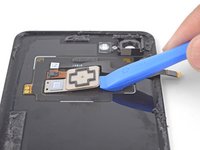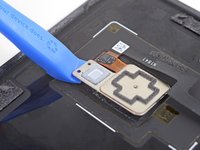简介
This repair guide was authored by the iFixit staff and hasn’t been endorsed by Google. Learn more about our repair guides here.
This guide shows how to remove and replace the fingerprint sensor for your Pixel 3 XL.
If you replace the fingerprint sensor, recalibrate the reader to maintain its functionality.
你所需要的
-
-
Heat an iOpener and apply it to the right edge of the back cover for a minute.
-
While you wait, note the following areas on the back cover:
-
Strong adhesive—there are large patches of adhesive near the bottom of the phone.
-
Fingerprint sensor cable—be careful not to slice through the cable as you pry
-
-
-
Apply a suction cup to the heated edge of the back cover, as close to the edge as possible.
-
Pull up on the suction cup with strong, steady force to create a gap.
-
Depending on the age of your phone, this may be difficult. If you are having trouble, apply heat to the edge and try again.
-
Insert the point of an opening pick into the gap.
Suction cup doesn’t work on severely cracked glass.
Step 1 - 2 took me about 50 minutes. Back and forth with heat and trying with suction cup. I could get my finger nail in but not the pick. Took two people, but we finally got a pick in. 2 year old phone.
I also struggled here for a while. I ended up working my way around the entire edge of the phone until I found one spot where I could pry up the back panel. I used a jimmy instead of the opening pics. I also used a hairdryer on lower heat instead of the iopener. 3 year old phone.
Took 30 minutes + to get the back cover off. Used another suction cup to grip from the busted screen and the ifixit suction cup for the back. A thinner Acoustic guitar pick was required opposed to the standard Blues picks provided in the kit (har-har). Would HIGHLY suggest getting a pick into both the back and the front before removing the panels as it will give you more surfaces to pry from. Made that mistake...
Over 2 hours of trying, I keep reheating the pouch and let it sit on the edge for sometimes up to 10 minutes since the directed 1 minute wasn't working. Physically cant get enough leverage on the back of the phone; picks are too thick to get under the crack, and the suction cup pops off before I can get enough force to see any gap open. Phone is 5 years old. I really need some help
Hey Grant!
I hear your pain—the adhesives on this phone are very strong. The initial gap is one of the hardest parts of the procedure. Here are some suggestions:
* If you have a hair dryer, give that a shot. Heat the edge until it is slightly too hot to the touch.* These adhesives separate not with extreme force, but with constant steady force and time. Try heating the edge and pull on the suction cup with firm force for about a minute to let the adhesive separate.
* If you have an opening tool, you can try this procedure to get the initial gap.
-
-
-
Slide the opening pick along the right edge to slice through the adhesive.
-
The adhesive gums up and becomes hard to slice once it cools. If that happens, re-apply heat to the edge to make slicing easier.
-
Once you have sliced through the edge, leave an opening pick in the seam to prevent the adhesive from re-sealing.
-
-
-
Apply a heated iOpener to the bottom of the back cover for a minute.
-
-
-
Use an opening pick to slice around the bottom right corner and continue along the bottom edge of the phone.
-
Leave a pick in the edge to prevent the adhesive from re-sealing.
-
-
-
-
Continue heating and slicing the remaining edges of the phone.
-
Be careful as you slice along the left edge of the phone. If your pick feels like it's stuck near the top, you may have snagged the fingerprint sensor. Retract the pick out of the seam slightly and try again.
-
Be sure to cut through the thick portions of adhesive near the bottom and right edge of the phone.
The back cover is Glass!!!!. DO NOT PRY HARD, IT WILL BREAK!!!!!!!
You must go slowly and let the heat do the work, if you force the cover off, it will shatter.
-
-
-
Gently pry up the right edge of the back cover.
-
Use an opening pick to slice through any remaining adhesive along the edges.
-
-
-
Swing the right edge of the back cover upwards and rest the flipped panel along the left side of the phone.
Reassembly is way harder. The adhesive guide is generic and not super helpful, so don't be surprised if things went smoothly until you get to this step and then everything starts sticking to things its not supposed to.
This is great but how you address that fact that the phone is tied to a particular fingerprint sensor and after replacing, the new sensor is not recognized by the original phone?
Hi Dave!
There's a software calibration tool that you can use to calibrate your new fingerprint sensor. I've updated this step to include a link to the tool.
I have a pixel 3 xl and I can't get the tool to work. I finally got the driver's installed after several hours and it says it's for pixel 6 and up basically. So I tried the other option and it's basically saying to do a factory reset? Did I mess something up on the install or what am I doing wrong here? Thanks
Uhhh
So, apparently the connector on the motherboard for the fingerprint sensor is just ridiculously fragile, because after plugging and screwing everything in (pretty much reassembled except for the adhesive), I closed up the phone and powered it on to test if everything was working, and when I opened it back up and let the top hang off to the side, it just snapped off. I didn't even have it tensioned that much, it was just hanging off to the side and snapped. So now I've traded a non-functional camera with a non-functional and irreparable (unless I get a new motherboard) fingerprint sensor.
The guide really ought to emphasize how delicate that connector really is. I have a google drive link here to a photo of the remnants of my poor fingerprint sensor connector :( link
Wasted a ton of time and effort (and money) trying to use this guide to repair my Pixel 3XL. Then I get to the software calibration tool and find:
Unsupported deviceThis is not a compatible device. Only Pixel 6, 6 Pro, 6a, 7, 7 Pro, 7a devices can install this software.
I cannot say how frustrating it is when a guide and website that tried to be so helpful ends up like this. Failure due to referencing tools not on the site and not suitable for the job.I too want to stress just how sensitive the fingerprint sensor cable is. Be sure you are only lifting the back away a very small amount until you are able to disconnect the cable. I thought I was being careful and ended up still putting a small tear in the cable!
The good news is that a replacement sensor is well under $10 shipped. Also, I'm not sure why this guide recommends the use of the software tool.
It is not compatible with the 3XL (and I'm not sure it ever was). I had some reservations when I read this when I had to replace my sensor, but I found comments else where stating that nothing was needed. Sure enough, when I got my new sensor installed, it worked with no issues. I didn't need to calibrate, or reset my device. I just needed to set my fingerprints up again.
-
-
在这个步骤中使用的工具:Tweezers$4.99
-
User tweezers to carefully peel up the yellow tape over the fingerprint sensor connector.
This step is utterly unnecessary. It achieves nothing, and the tape is there for a reason (I'm not sure why, maybe to prevent short circuits). I didn't remove this tape while disassembling and it didn't change anything.
The Kapton tape should adhere to both the cable and the connector. It helps prevent the cable from slipping out of the ZIF connector. You're right in that you don't have to completely remove the tape—I've adjusted the step to reflect this.
I just finished this guide, thank you. It would be nice to have a "before ribbon removed" reference picture that's also without the Kapton tape in place if possible. I was no longer certain how far back into the ZIF connector I had to place the ribbon cable as I simply forgot what it looked like before removing it. Basically, it "felt" like it was out too far, but since I had no reference I couldn't compare. Step 10 has good close up pics, but the ribbon cable is already out a bit so a bad reference.
teknomedic - 回复
-
-
-
Use the point of a spudger to carefully flip up the black lock bar on the fingerprint sensor's ZIF socket.
-
Grasp the cable's tab with your fingers or tweezers and gently walk the flex cable out of the socket.
-
-
-
Apply a heated iOpener over the fingerprint sensor for a minute.
-
-
-
Insert the edge of an opening tool underneath the square portion of the fingerprint sensor and slowly pry up to loosen the sensor.
-
Continue prying around the perimeter of the fingerprint sensor until it is loosened.
-
-
-
From the outer side of the back cover, use your finger to push the fingerprint sensor out of its cutout.
-
-
在这个步骤中使用的工具:Tesa 61395 Tape$5.99
-
Remove the fingerprint sensor.
-
To reassemble your device, follow these instructions in reverse order.
Repair didn’t go as planned? Try some basic troubleshooting, or ask our Answers community for help.
To reassemble your device, follow these instructions in reverse order.
Repair didn’t go as planned? Try some basic troubleshooting, or ask our Answers community for help.
11等其他人完成本指南。
4指南评论
Can you please tell me what the square flex circuit (with 2 square contacts) is for, which is surrounding the FP Sensor? Mine was damaged, when my back cover was cracked. I have replaced the back cover, and will be getting another FP sensor (as mine is inoperable), but that large square flex is also damaged. I have no idea what this is for? I thought it was connected to the NFC circuit, but the phone still charges wirelessly.
I think that is the NFC antenna, which is mainly used for contactless payment and ID systems. It’s not used for wireless charging, which is the coil on top of the battery. Depending on how it is damaged, your NFC function may still work—it may just have less range if the antenna’s damaged.
The link to the Google tool to get the Pixel 3XL phone to recognize the new fingerprint sensor only works for Pixel 6 and newer. Perhaps the tool accessed by the link previously supported the Pixel 3XL, but no longer does. Either a correct reactivation tool for the Pixel 3 should be provided or this guide should be taken down. As it stands, it seems useless to replace the sensor unless a way is provided to get the phone to recognize the new one. If there is an alternate way to activate the new sensor, the method should be provided in the guide.
No recalibration of a new sensor is required on the 3XL. You can replace a broken sensor with a new one and it should be properly detected by the phone.
No software should be necessary, though you will likely have to setup fingerprints again. When the fingerprint sensor is broken, the phone software may not detect it and Android will not even give you the options to configure fingerprints. Once a working sensor is installed, it should provide the options again.
This guide is wrong when it describes a recalibration for the 3XL, it is likely that this was cut/pasted from another device.















